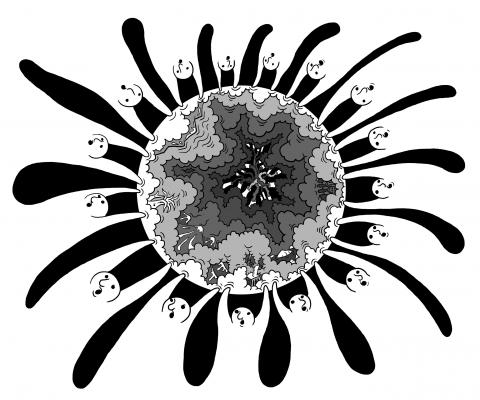At 15 years old, Margarita Naumenko is one of the youngest participants in Russia’s Fridays for Future climate protest movement.
Each week, she stands in downtown Moscow with other young activists chanting, brandishing posters and demanding the government take action on worsening climate change threats.
Her parents support her decision to protest, but they are less convinced about the urgency of slowing climate change, Naumenko said.

Illustration: Mountain People
“I tried talking to them and changing their opinion,” she said. “But that is not easy.”
Led largely by young people, Russia’s nascent climate protest movement has taken on the challenge of changing minds in a country where, not long ago, both the public and politicians were skeptical about the need to act quickly on climate change.
The protests may be having some effect. Earlier this month, Russia said it would join the 2015 Paris Agreement to fight climate change — one of the last countries in the world to do so.
It is the world’s fourth-largest emitter of greenhouse gases and was the biggest emitter not to have agreed to the landmark global climate deal.
Before the announcement, activists in Moscow held about 50 individual protests, after previously having been denied a permit to demonstrate as part of a large-scale global climate strike in February.
Naumenko joined the movement five months ago, inspired after attending a lecture on improving sustainability in the education system and after seeing Greta Thunberg, the 16-year-old figurehead of the youth climate movement, speak on television.
“I thought: ‘Why don’t I take any action,’” Naumenko said. “We have just one planet. If we do not care about it, who else will?”
GROWING PROTESTS
Since the first mass eco-protest in Moscow’s Sokolniki Park in March — a day students around the world walked out of their classes to call for action on climate change — other Russian cities, such as St Petersburg, Nizhny Novgorod and Irkutsk, have joined the climate campaign.
For Arshak Makichyan, it was the March protest in Moscow that sparked his involvement in climate activism.
Since then, the 25-year-old violinist has become one of the faces of Russia’s youth protest movement, demonstrating every week, often on his own.
He also acts as one of the coordinators of the movement, and part of his job is to apply for official permission to protest, which can be a time-consuming and frustrating process, he said.
New rules adopted after mass protests in Moscow that followed Russian President Vladimir Putin’s 2012 election made it a criminal offense to stage some forms of non-violent protests without a permit.
Single-person protests, on the other hand, do not require a permit, Makichyan said.
However, they do have restrictions — for example, in Moscow, protesters must not stand closer than 50m from each other.
Makichyan said that, so far, Russia’s climate activists have succeeded in getting permits for two large-scale environmental protests.
The crowds at protests have been getting bigger over the past few months, he added.
These days, an organized climate demonstration in Moscow attracts between 20 and 40 participants.
The number might be small compared with the thousands who come out for protests in other cities around the globe, but it is a big increase from when Russia’s activists first started, Makichyan said.
“The numbers have been growing,” he said. “Ten weeks ago, I was very often protesting on my own. Now every week we get more participants and new cities join in.”
Russia’s government has a history of cracking down on protests that it has declared illegal.
In a case in July that triggered global condemnation, police in Moscow detained more than 1,000 people for taking part in a protest calling for opposition members to be allowed to run in a local election.
Makichyan, who took part in that protest and was detained for three hours, said so far there have been no arrests during any of the climate protests.
Gathering to demand action on the environment is not something new to Russians, climate groups say, but previous grassroots campaigns tended to focus on local issues, such as air pollution, destruction of green zones and waste management.
LOCAL TO GLOBAL
Recent climate disasters such as the wildfires that raged across Siberia earlier this year, destroying at least 3 million hectares of forest, have turned the public’s attention toward the global crisis, Greenpeace Russia spokesman Konstantin Fomin said.
In a report published in 2014, Russia’s main meteorological service Roshydromet warned that the country is warming more than twice as fast as the rest of the world.
At a climate forum last month, Russia’s presidential climate adviser Ruslan Edelgeriev said that this year so far global warming has caused 9.5 billion rubles (US$145.9 million) of damage to the country’s agricultural sector.
Most of that is due to losses from wildfires and droughts, he said.
“[Now] many Russians have personally experienced the effects of climate change. These factors have led civil society to take climate change more seriously,” Fomin said.
A poll conducted in December last year by the Moscow-based Public Opinion Foundation, a think tank, showed that 84 percent of Russians have heard about climate change, while almost two-thirds believe it is serious and happening.
More than half of Russians think that people should work to stop climate change, the poll found.
“Almost all people in Russia understand and acknowledge that the climate is changing, that this is serious, and they would like to know more about it,” WWF Russia energy and climate program head Alexey Kokorin said.
While a few years ago Russian politicians and businesses were arguing that a warming climate would only benefit the country, the government is now putting the issue of climate adaptation higher on its agenda, Kokorin said.
In the past two months, Russia announced it was working out the country’s first climate adaptation plan as well as a long-term, low-carbon development strategy for the country’s economy, which is today heavily based on gas and oil.
FRESH AIR, CLEAN WATER
For Fomin, all of these developments are a boost to Russia’s nascent climate protest movement.
“With the support of society, Russian climate activists can become not just another environmental organization, but a real mass movement,” he said.
Veronika Essen, 25, said she joined the protests out of concern for her five-year-old sister’s future.
“In 11 years, when she is 16, we probably won’t be able to prevent the negative consequences of the climate crisis,” said Essen, who works in marketing. “But I really want her to enjoy fresh air, clean water and travel around the world, instead of living amidst the climate catastrophe.”
Essen said she began looking for like-minded young people, which led her to the climate march movement.
“I thought that I would be embarrassed standing in a single-person protest, when people would approach me, ask questions, argue with me and take photos of me,” Essen said.
“Now I want to come out every Friday, regardless of whether the protest action has been approved by the authorities,” she said.

Taiwan has lost Trump. Or so a former State Department official and lobbyist would have us believe. Writing for online outlet Domino Theory in an article titled “How Taiwan lost Trump,” Christian Whiton provides a litany of reasons that the William Lai (賴清德) and Donald Trump administrations have supposedly fallen out — and it’s all Lai’s fault. Although many of Whiton’s claims are misleading or ill-informed, the article is helpfully, if unintentionally, revealing of a key aspect of the MAGA worldview. Whiton complains of the ruling Democratic Progressive Party’s “inability to understand and relate to the New Right in America.” Many
US lobbyist Christian Whiton has published an update to his article, “How Taiwan Lost Trump,” discussed on the editorial page on Sunday. His new article, titled “What Taiwan Should Do” refers to the three articles published in the Taipei Times, saying that none had offered a solution to the problems he identified. That is fair. The articles pushed back on points Whiton made that were felt partisan, misdirected or uninformed; in this response, he offers solutions of his own. While many are on point and he would find no disagreement here, the nuances of the political and historical complexities in
Taiwan faces an image challenge even among its allies, as it must constantly counter falsehoods and misrepresentations spread by its more powerful neighbor, the People’s Republic of China (PRC). While Taiwan refrains from disparaging its troublesome neighbor to other countries, the PRC is working not only to forge a narrative about itself, its intentions and value to the international community, but is also spreading lies about Taiwan. Governments, parliamentary groups and civil societies worldwide are caught in this narrative tug-of-war, each responding in their own way. National governments have the power to push back against what they know to be
Taiwan is to hold a referendum on Saturday next week to decide whether the Ma-anshan Nuclear Power Plant, which was shut down in May after 40 years of service, should restart operations for as long as another 20 years. The referendum was proposed by the opposition Taiwan People’s Party (TPP) and passed in the legislature with support from the opposition Chinese Nationalist Party (KMT). Its question reads: “Do you agree that the Ma-anshan Nuclear Power Plant should continue operations upon approval by the competent authority and confirmation that there are no safety concerns?” Supporters of the proposal argue that nuclear power